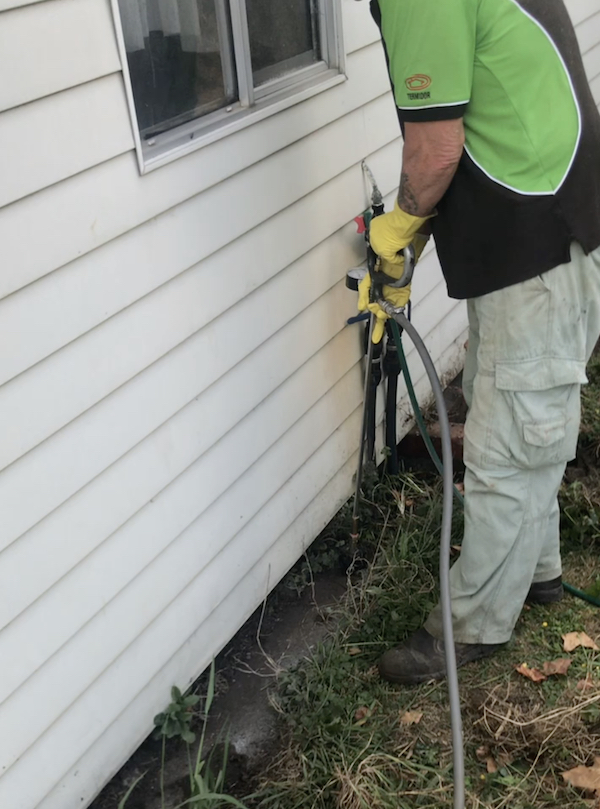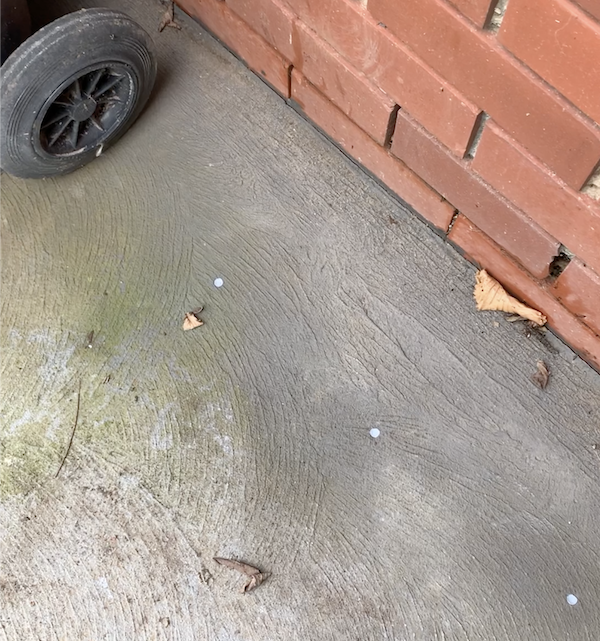Carrying out a termite treatment to the soil around and under a building with insecticide, is a proven way to protect a building from termite attack. But how do these termite soil treatments actually work?
It’s worth knowing a bit about these termite treatments – they aren’t just set and forget. As a homeowner, there are a number of things you should and shouldn’t do, to make sure the treatment provides lasting protection from termites.
First, let’s look at the termite treatment chemicals, the insecticides (termiticides) that are applied to the soil.
Termite treatment chemicals
There are two types of termite treatment chemicals used for soil treatments – repellent insecticides and non-repellent insecticides.
Repellent insecticides are an older type of insecticide (termiticide). As their name suggests, termites can detect their presence in the soil and are repelled by them. It is of course important to ensure that any treatment with a repellent chemical is continuous around the property, as termites can readily find gaps in such treatments.
The newer types of termiticides, such as Termidor, are non-repellent. Termites cannot detect their presence and are actually killed when they enter a treated area. Such chemicals are seen as “forgiving”, as even if there are small gaps in the treatment, the termites cannot actively find these gaps and so the chances of them accurately walking through a gap in the treatment by chance, without also entering a treated area, is negligible.
It is for this reason that Termites VIC use Termidor and why Termidor can offer a $2 million Assurance Warranty.

Termite Barrier or Treated Zone?
The term, “termite barrier”, is commonly used when discussing soil termite treatments. The term came into popular use when the repellent termiticides hit the market, as their repellent mode of action made it easy to visualise the treatment as a termite barrier. However, with the newer non-repellent termiticides, the concept of a termite barrier does not have quite the same meaning, and so nowadays termite soil treatments are often called treated zones.
Trenching and Drilling
Termite treatments need to be applied to the soil to create a continuous treated zone. Typically, the best way to do this is to dig a trench down to 50 mm below the top of the foundations and soil is treated with chemical as it is backfilled. Sometimes if the quality of the soil is poor (either heavy clay or rocky) it may need to be replaced before treatment / back-filling.

If there are pavers around the perimeter of the building, they will need to be lifted up and the sand / soil treated underneath before the pavers are re-laid.
If there is a hard surface around the perimeter of the building (such as concrete or tiles), the best practice is to cut and lift the concrete / tiles, to allow the soil underneath to be treated. However, this is often not acceptable to homeowners, especially in the case of tiles. In such circumstances, it is possible to drill holes between the tiles to inject the chemical. This is a higher risk treatment, as you can never see what is actually happening underneath the hard surface and can never be sure whether the chemical has been evenly applied. However, such is the quality and confidence that the manufacturer has in Termidor, that they will still offer their $2 million Assurance Warranty to treatments applied by a Termidor Accredited installer such as Termites VIC.

Termite treatments prevent concealed termite entry
A key point to understand is that termite treatments do not provide 100% protection from termite attack. When a termite soil treatment is correctly installed, it prevents 100% protection from termites gaining access to a building through a concealed entry point.
Termite soil treatments are designed to work in conjunction with the physical construction elements of the building, to prevent termites accessing hidden entry points. For example, a concrete slab provides a solid physical barrier that prevents termites entering a building, but with termites able to squeeze through gaps as small as 2 mm, the join between the concrete slab and the exterior brick walls needs to be protected. By treating the soil that abuts the join between the slab and the wall, these concealed potential termite entry points are protected.
If a termite soil treatment has been correctly installed, for termites to access the building, they will need to build their mud tubes around these treated zones. For example, they may build a path across a twig that has fallen across the treated zone.
It is for this reason, that annual professional termite inspections are required to maintain the warranty on any soil treatment.
How long do termite treatments last?
How long a termite treatment lasts will depend on a number of factors:
- The type of chemical used.
- The weather conditions (warmer temperatures and higher rainfall reduces the duration)
- Soil type
A Termites VIC we warranty our Termidor soil treatments for 5-8 years, providing we also carry out annual termite inspections. Furthermore, as accredited Termidor installers, our treatments are also backed by the Termidor $2 million Assurance Warranty.
What do you need to do to maintain your soil termite treatment?
Firstly, make sure you have an annual professional termite inspection every year. Not only will this allow the termite inspector to spot any termites trying to access the building by constructing mud tubes over the treated zone, but the inspector will be able to spot areas where the treated zone may have been compromised.
It is important for homeowners to visualise a termite soil treatment as a continuous soil treatment around their property and realise that any activity that may create a gap or otherwise compromise this treated zone could allow termites to enter the building without being noticed.
Here are some common activities which may compromise a treated zone:
- Building work (especially digging associated with utility pipes)
- Dogs digging
- Gardening – digging or planting plants.
- Adding soil on top of a treated zone
- Installing a hard surface over a treated zone
- Building a deck or extension over a treated zone
Ideally avoid these activities or speak to your pest manager before starting on these activities, so that guidance can be provided on maintaining the termite protection.
Click here for more information about our termite treatments in Melbourne and Gippsland.
